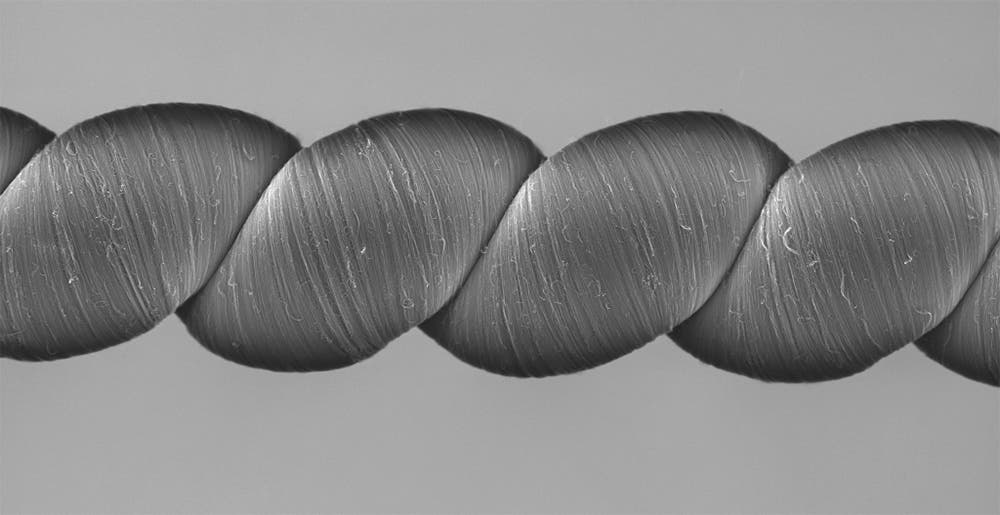An international research effort has produced high-tech yarns that pump out electricity when stretched or twisted.
The “Twistron” yarns are the product of a research team led by scientists from the University of Texas at Dallas and Hanyang University in South Korea. Due to the high rate with which the twistrons transform motion into electricity, they could be used to tap into ambiental energy sources. Ocean waves, waste heat, even our breathing motions could be harvested for usable power.
Twist and turn on
“The easiest way to think of twistron harvesters is, you have a piece of yarn, you stretch it, and out comes electricity,” said Dr. Carter Haines, co-lead author of the paper and an associate research professor in the Alan G. MacDiarmid NanoTech Institute at UT Dallas.
The yarns are built from carbon nanotubes, hollow carbon cylinders which are about 10,000 times thinner than a strand of human hair. The team spun these into high-strength yarns, then twisted them until they coiled to make them elastic. The last step was to coat the strands with an electrolyte (an ionically conductive material), which can be something as mundane as a water and salt solution. The end result, the twistron, acts much like a supercapacitor. A capacitor is a device used to store electrical charges, and they usually require an external source of current such as a battery. But these yarns are capacitors capable of generating their own charge.
The fundamental working principle is that when the nanotube yarns get pushed into the electrolyte, they become electrically charged. Because of the twist imparted onto the strand, whenever the Twistron is twisted or stretched its volume decreases, bringing the electric charges on the yarn closer together and increasing the overall energy of the strand, Haines said. This increase translates into a higher voltage across the yarn. In essence, mechanical motions in our scale of reference lead to changes on a very small scale that produce energy we can harvest.
According to the study’s corresponding author, Dr. Ray Baughman, director of the NanoTech Institute, 30 stretches a second generated 250 watts per kilogram of peak electrical power normalized to the harvester’s weight (i.e. this is a calculated value). Which is actually quite a lot of energy from simple motion.
“Although numerous alternative harvesters have been investigated for many decades, no other reported harvester provides such high electrical power or energy output per cycle as ours for stretching rates between a few cycles per second and 600 cycles per second,” he explains.
Experimentally, a twistron yarn weighing a few milligrams (for comparison, a typical male housefly weighs around 11,5 mg) could light up a small LED on every stretch. When sewed into a shirt, the yarn generated an electrical signal on each breath, showcasing its potential as a self-powered breathing biomonitor. To make it able to tap into wasted thermal energy, the team connected the Twistron to an artificial polymer muscle which contracts and expands with temperature.
All of this could mean that Twistron technology is ideally-suited to power wearable electronics and supply energy for really small devices where batteries would simply be impractical.
“There is a lot of interest in using waste energy to power the Internet of Things, such as arrays of distributed sensors,” said Dr. Na Li, a research scientist at the NanoTech Institute and co-lead author of the study.
Bigger fish to fry
It’s not all about the very small, however. The team also wanted to show that their strands can be used to tap into currently under-exploited forms of power, such as sea waves. As a proof-of-concept demonstration of both this and the strands’ ability to work in more chemically-complex environments, such as ocean water, the team deployed a Twistron on the east coast of South Korea. A 1-milligram, 10 centimeter-(4 inch-) long strand was tied to a balloon on one end and a weight that rested on the seabed. With every wave, the balloon would rise and stretch the yarn by up to 25%, generating electricity.
Although it only produced very small amounts of power in this attempt, the team showed that the technology’s output is scalable either by increasing diameter or by employing bundles of the strands in parallel. The only barrier to their mastery of wave-energy is cost, as building enough strands for this application would be quite pricey. However, for applications requiring relatively low levels of power, such as sensors or sensor communications, you only need small twistrons — which don’t cost very much. The team reports that “just 31 milligrams of carbon nanotube yarn harvester could provide the electrical energy needed to transmit a 2-kilobyte packet of data over a 100-meter radius every 10 seconds for the Internet of Things.”
The paper “Harvesting electrical energy from carbon nanotube yarn twist” has been published in the journal Science.










